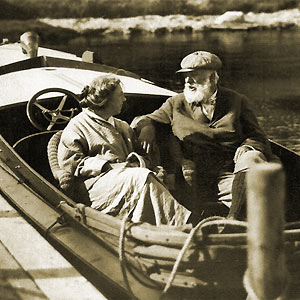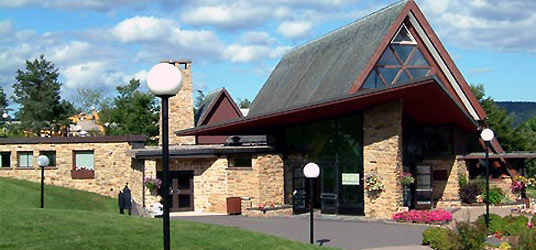 |
Alexander Graham Bell National Historic Site |
||||||
Alexander Graham Bell moved with his family to Baddeck after their first visit to the area in 1885. Their home, Beinn Bhreagh, (Gaelic for 'beautiful mountain'), was a refuge and a family gathering place for Bell, his wife Mabel, and their daughters. The Lakes were important to Bell's experimental work. In the early 1900's, during his experiments about aviation, kites, some large enough to carry a person, were launched from rafts towed behind boats and even a steamship. Travelling around the Lakes in their houseboat and, in later years, on the yacht “Elsie”, a gift to their daughter Elsie, was a source of enjoyment for the Bell family and their friends. "I have travelled the globe. I have seen the Canadian and American Rockies, the Andes and the Alps and the highlands of Scotland, but for simple beauty, Cape Breton outrivals them all." Bell A leurs morts, Alexander Graham Bell (2 août 1922) et Mabel Hubbard Bell (3 Janvier 1923), ont été enterrés sur le sommet de la montagne à Beinn Bhreagh. Upon their deaths, Alexander Graham Bell (2 august 1922) and Mabel Hubbard Bell (3 january 1923), their remains were buried on the mountain top at Beinn Bhreagh. Today, Alexander Graham and Mabel Bell's home belongs to their descendants and Alexander Graham Bell National Historic Site is located on the Baddeck side of the Bay with a fine view of Red Head Peninsula and Beinn Bhreagh which can be viewed from the rooftop gardens of the complex. |
 |
| This complex contains the largest collection of Bell's artifacts and inventions. The major historical resources at the site are the large collection of artifacts related to Alexander Graham Bell's research, which he conducted both at Baddeck and elsewhere; books, photographs and copies of material from his personal archives; and various personal items, furniture and awards received by Bell during his lifetime. |
 |
Most artifacts are original, but there are some reproductions that are also valuable, particularly ones such as the HD-4 reconstruction, which incorporate original parts. Some archival materials are original, others are valuable copies of original transcriptions located elsewhere.
At ‘Alexander Graham Bell National Historic Site’ the story of Alexander Graham Bell is presented in several exhibit halls:In the reception and orientation hall, "Home" tells the story of Beinn Bhreagh, the Bells' Baddeck estate, and the story of Mabel Hubbard Bell. A gallery called "Sound and Silence" tells the story of Bell's work teaching deaf people to speak. In "Ideas", the wide range of experiments carried out by Bell and his associates is illustrated. The "Air" : Bell's work with man-carrying kites and airplanes, including original parts from the Silver Dart airplane. |
Seasonal kite-making workshops and Experiment program activities designed especially for children. This site is proud to present a new exhibit, "Kites of the World", featuring kites illustrating several of the popular styles which Bell might have encountered on his journey across the globe. The final exhibit area, "Water," presents the story of Bell's and Casey Baldwin's experiments with hydrofoil craft, culminating in the success of the HD-4. |
| Source : Smithsonian Institution - Fitzgerald Canada - Parks Canada - AT&T - National Geographic Magazine (Vol. XIV, No.6, June 1903) - Alexander Graham Bell National Historic Site - Dictionary of American Biography Base Set. American Council of Learned Societies, 1928-1936. Photos : Library and Archives Canada - Library of Congress American Memory - Smithsonian Institution - National Geographic |
Alexander Graham Bell National Historic Site |
||||||